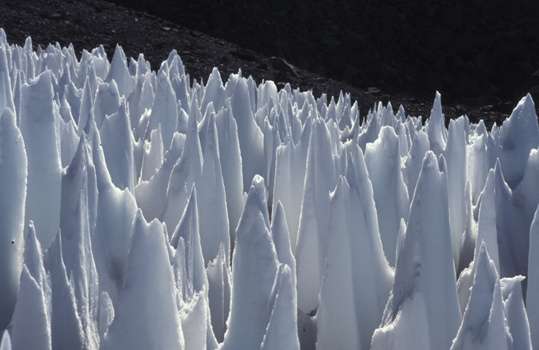October 1, 2015 report
Researchers further explain unique high altitude snow formations

(Phys.org)—A team of researchers with the Institute of Industrial Physics and Chemistry in France, has modified an explanation for the formation and spacing of high altitude snow formations known as penitents. In their paper published in the journal Physical Review E, the team describes how they believe the formations come about and suggest it is a process that might also occur on other planets.
Penitents are striking snow formations, named for an order of Spanish monks—they form as groups of spikes across a landscape, three to ten feet tall and just three or four inches wide. They only exist at very high altitudes, such as in the Andes. Back in 2001, Meredith Betterton undertook a study of the formations and offered a theory on how they form—she suggested they come about due to the differences in the rate of sublimation that occurs in tiny peaks that form when snow falls, and equally tiny valleys around them. Sunlight would get trapped, she believed, in the valleys, bouncing around and the heat would cause even more sublimation to occur in those valleys, until a spike was formed.
But, there was still one question left unanswered by Betterton—why are the spikes spaced apart the way they are? Her definition alone would suggest spikes would have varying distances between them, yet the physical evidence proves otherwise. This is where the researchers with this new effort come in, they suggest there is more at play than just sublimation, there is also the degree of humidity in the air that covers a field over the formations. They propose that the light that is absorbed in the snow causes a temperature gradient to form based on how steep and thick the snow is, and the amount of sublimation is constrained by the degree of humidity in the immediate area. Heat, they point out, would be radiated less efficiently in valleys, which suggests a wider temperature gradient, and that in turn would increase the sublimation rate. Thus, the distance between the spikes is dictated by the sublimation rate.
The researchers note that similar conditions likely exist on other planets, moons, or other space objects—wherever there is ice and exposure to strong solar radiation, there is likely to be penitents they theorize.
More information: Physical processes causing the formation of penitentes, Phys. Rev. E 92, 033015 – Published 25 September 2015. dx.doi.org/10.1103/PhysRevE.92.033015
ABSTRACT
Snow penitentes form in sublimation conditions by differential ablation. Here we investigate the physical processes at the initial stage of penitente growth and perform the linear stability analysis of a flat surface submitted to the solar heat flux. We show that these patterns do not simply result from the self-illumination of the surface—a scale-free process—but are primarily controlled by vapor diffusion and heat conduction. The wavelength at which snow penitentes emerge is derived and discussed. We found that it is controlled by aerodynamic mixing of vapor above the ice surface.
Journal information: Physical Review E
© 2015 Phys.org



















